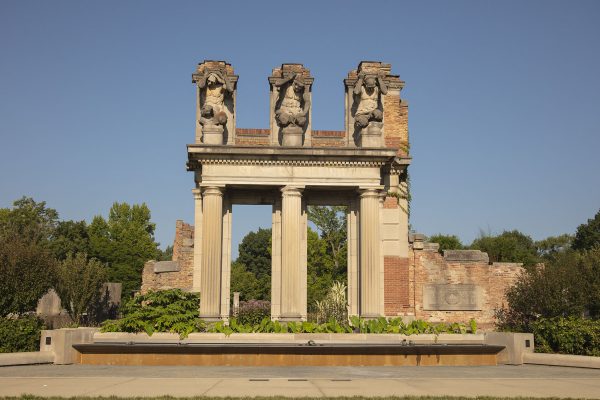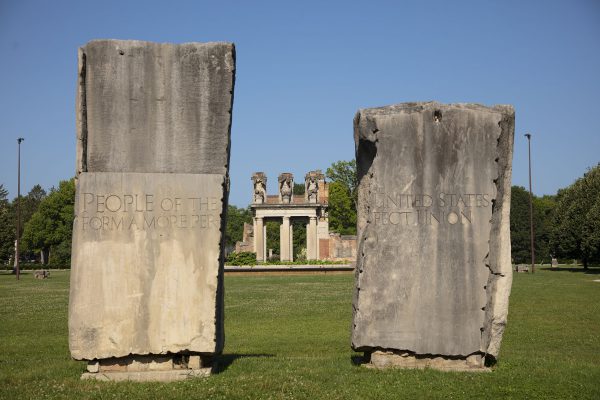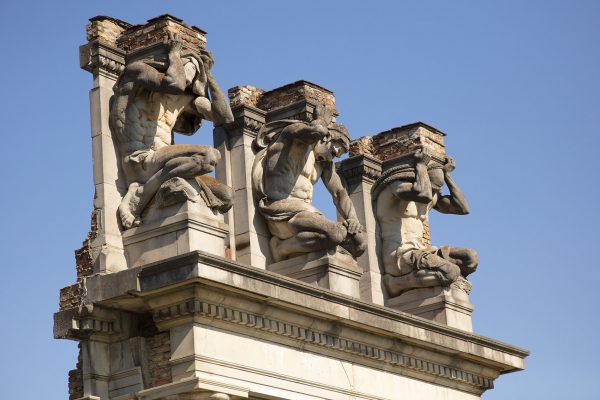For several years now, friends would speak wonders about the Ruins in Indianapolis and encouraged me to visit. I never really understood what they were, so just this past month, I made the trip to Indy and learned much about the sculptures. If you’re unfamiliar, the Ruins are, well, ruins; preserved in a state of, eh-hem, semi-ruin just west of Broad Ripple in Indianapolis’s Holliday Park.
Formally known as The Races of Man, the sculpture was once part of the front façade of the St. Paul Building in Manhattan. Built in 1898, the 315’ tall building reached 26 stories into the New York sky and served as one of the city’s first skyscrapers.
On the Broadway side of the building, just above the entrance, the renowned sculptor Karl Bitter chiseled the Races of Man out of a block of Indiana limestone. Bitter’s idea was that the three atlantes would look like they were holding up the building, just as Atlas held up the world. Each statue featured a different ethnicity working together in the spirit of 1890s American Progressivism.
The building had many tenants over the years but was eventually sold to Western Electric Corporation. In the 1950s, Western Electric opted to demolish the building but sponsored a contest to preserve St. Paul’s iconic artwork. Several cities and organizations proposed plans, including Indianapolis, Columbia University, MIT, the United Nations, and Rochester, New York. Indianapolis won the bid in 1959.
The winning plan was based on a design made by the Indianapolis artist Elmer Taflinger. According to Historic Indianapolis, “Taflinger’s design called for the eight-ton statues to be incorporated into a recreation of the St. Paul’s facade, which rose before a reflecting pool complete with dual geysers.”
The statues arrived in 1960 and were erected in Holliday Park. Taflinger then spent most of the next two decades modifying, redesigning, and incorporating new sculptures into his original plan. The project, however, was never completed as Taflinger intended. Divergent city administrations came and went, each with differing objectives and funding options. Plus, the artist’s never-ending tinkering left the project in a permanently unfinished state, no doubt frustrating even his allies.
In the early-1970s, then-mayor Richard Lugar asked the parks department to complete the installation, which they did, formally dedicating the Ruins in 1973. Then in 1976, at the nation’s bicentennial, a reflecting pool was added on the statue’s east side, and the giant slabs of limestone were placed in front of statues.
Holliday Park is historic in its own right. In 1916, in celebration of Indiana’s centennial, John and Evaline Holliday donated their 80-acre countryside estate to the city of Indianapolis. According to the Indy Arts Guide, “It was Holliday’s intent that the land be used for recreation and the study of nature, and the grounds as a public park and playground.” Holliday Park officially became part of the city park system in 1932 and, 28 years later, became a home for the Ruins.
Taflinger gave up the ghost in 1981. And within a decade, the Ruins were overgrown and in, well, ruin. As a result, a local fundraising effort was launched to preserve the sculptures, spearheaded by The Friends of Holliday Park. As Indiana celebrated its bicentennial in 2016, a $2.3 restoration of the Ruins was completed, giving the site the interpretation we know today.
When you go, try to aim for morning or evening, when the sun is at an angle; the light is genuinely spectacular during ‘magic hour.’ Also, leave time to explore Holliday Park, an incredible sprawl of green along the White River. I hiked the trail back to the river, and it was lovely - easy to navigate and shaded the whole way. It’s definitely worth the trip.











